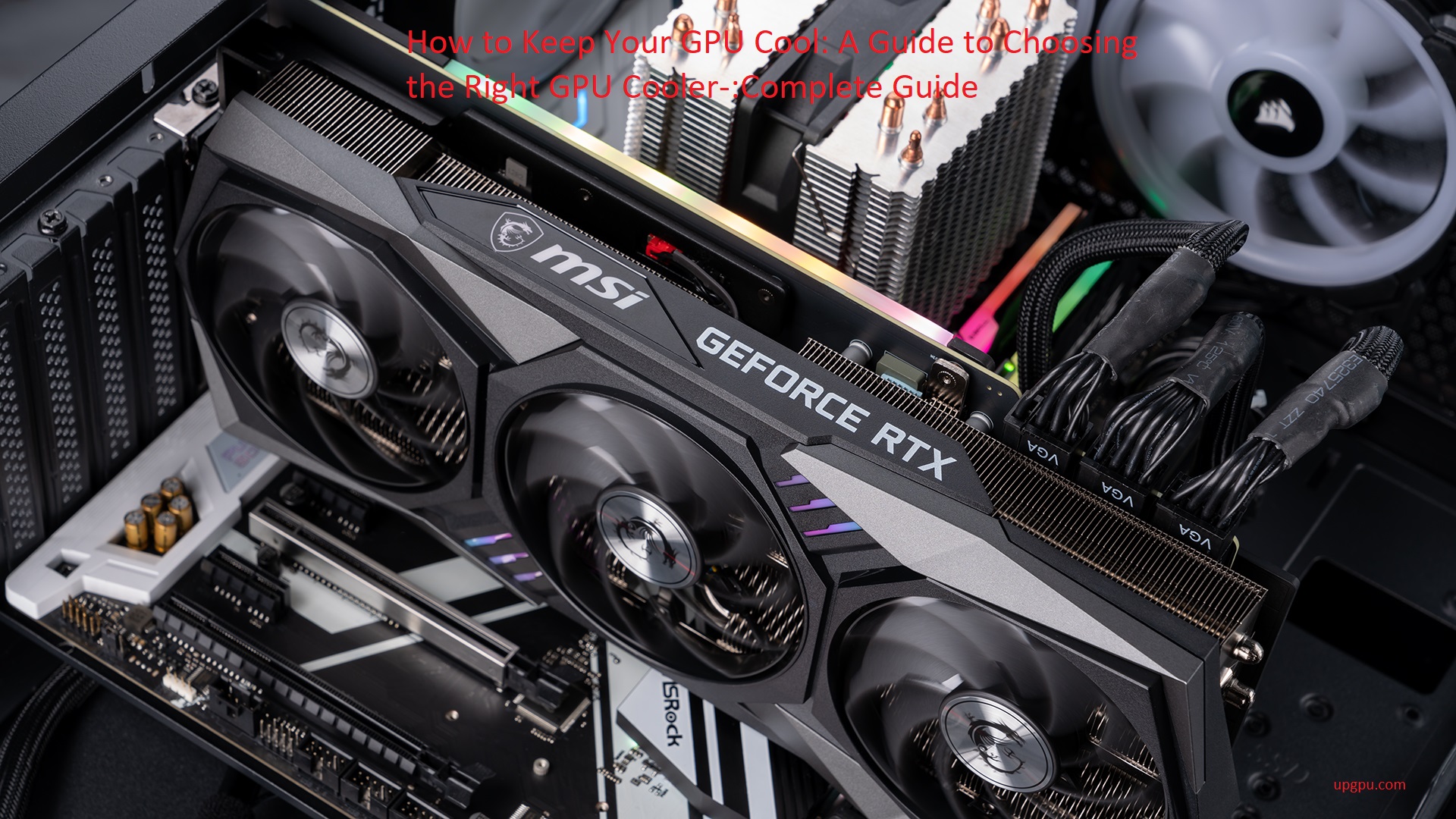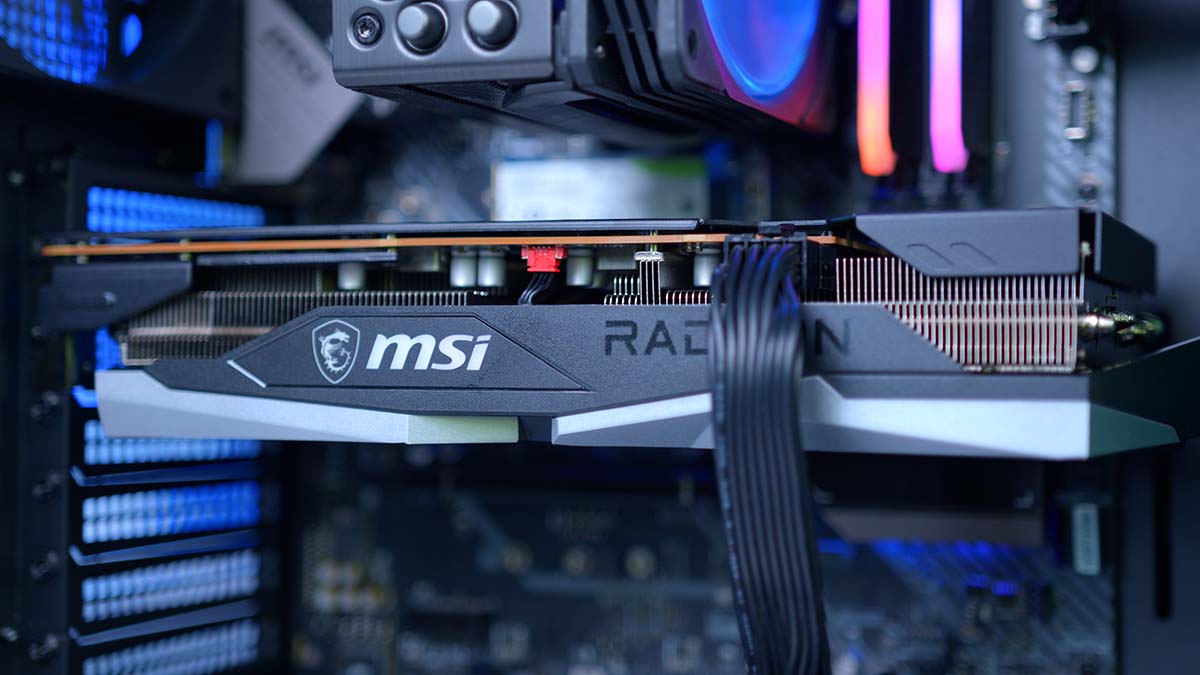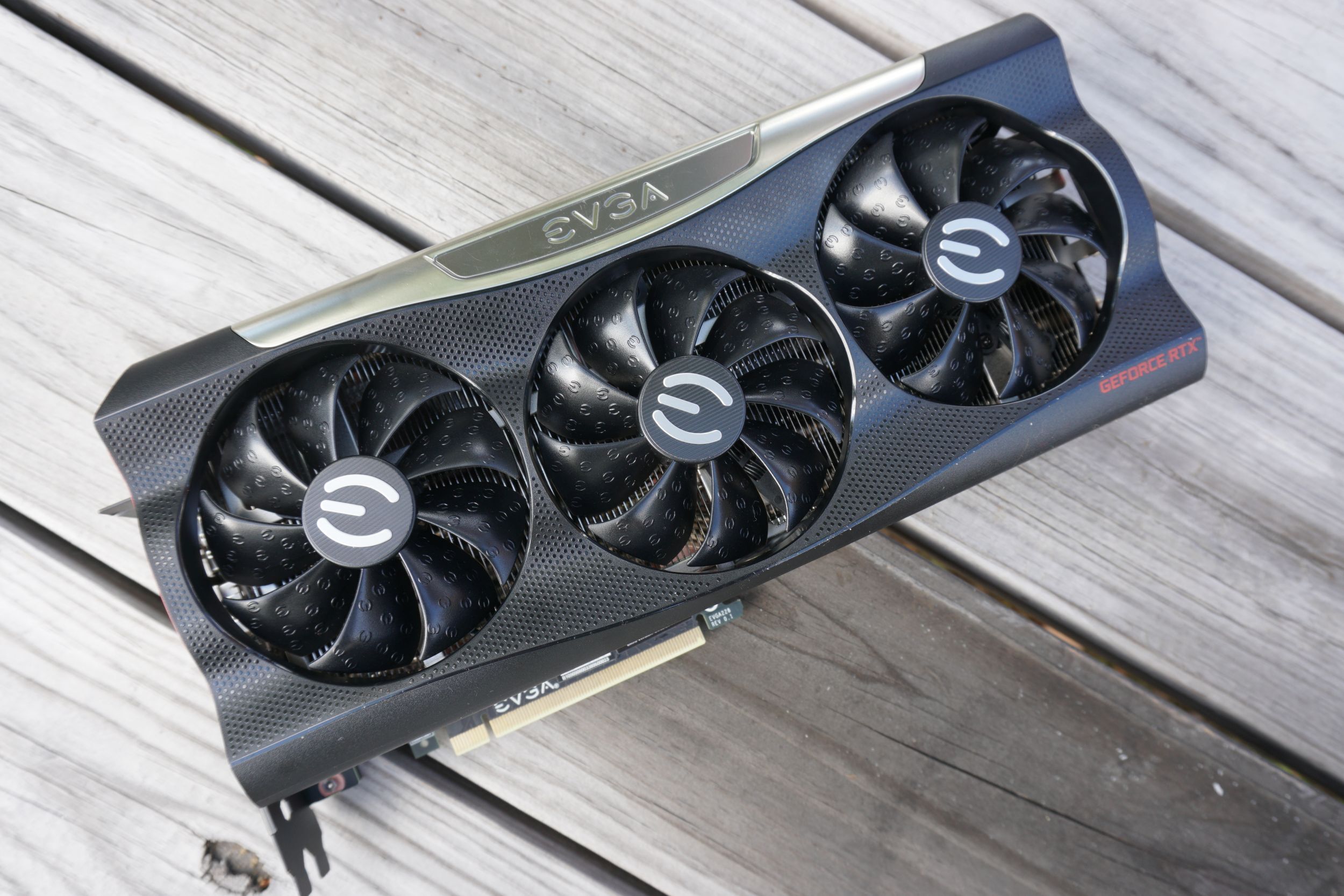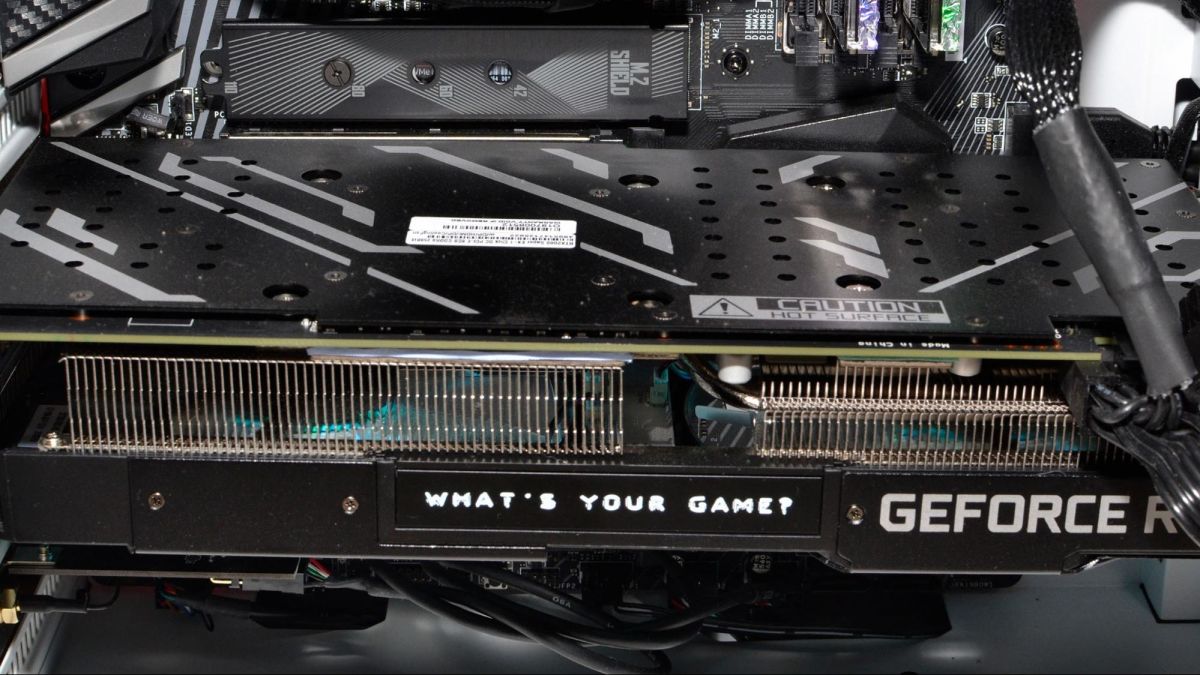Do you have a powerful graphics card in your gaming PC? Are you worried about it getting over-heated and affecting your gaming experience?
Then worry no more, for this article will help you choose the right GPU cooler to ensure that your GPU is running at optimal temperatures. You will no longer have to fear game crashes caused by overheating!
It’s easy to forget that your graphics card, or GPU, stands for Graphics Processing Unit and every year processors are being pushed to perform more tasks faster. And it’s worth knowing that all of this has a cost: increased heat generation.
To ensure that your hardware works at its best and stays in optimum condition, it’s not just important (but vital) to have adequate cooling for it. For example, if the temperature of your GPU rises above the manufacturer’s specified safe operating temperature level for a prolonged period of time, this can cause permanent damage to the card or even shorten its lifespan significantly.
This guide seeks to provide an introduction on why it is important to keep your GPU cool and offers several different options on how you might achieve this. It goes over a few common GPU cooler types as well as recommendations from both AMD and Nvidia on what temperatures you should aim for. Finally, there are some useful reference tables which provide data on how much noise each type of cooler can make and other information such as airflow rate and fans sizes available too.

Importance of keeping your GPU cool
A graphics processing unit (GPU) is an integral part of a computer system, and like all parts of a PC, it must be kept at its optimum temperature. A GPU generates a lot of heat and therefore must be equipped with a cooler in order to keep the temperatures in check. If the GPU runs too hot for too long, it may cause permanent damage to components or even total failure.
That said, choosing the right GPU cooler is very important in order to get optimal cooling performance from your graphics card. There are several factors to consider when selecting your GPU cooler such as compatibility with your specific graphics card model, size and form factor of the cooler, noise levels and more.
For the best results, find a coolers that has been designed specifically for your particular graphics card model – this ensures compatibility and performance optimization. Additionally take into consideration ambient temperature inside the case since this can vary greatly depending on case type (Full Tower vs Mid Tower vs Mini ITX). Factors such as CPU TDP , fan placement , drive bay locations can also affect cooling performance of your graphics card so be mindful of that as well. Size and form factor should also be taken into account since some coolers may not fit inside certain cases due to its length or shape. Noise levels should also be considered if you’re looking for a quieter system which means you should look for coolers that have quieter operation than average . Finally consider the weight of the cooler which will add torque load onto baseplate mountings so opt for lighter models if possible.
Overview of the article
This article provides an overview of GPU coolers and the importance of cooling systems for your computer. It examines different types of cooling systems, such as fans, liquid cooling, and water-cooling. Additionally, it discusses the features that should be looked into when selecting a cooler such as size, power consumption, noise emission and pricings.
Finally, it gives practical tips on how to choose a suitable cooler based on your computer’s specifications and other factors. As mentioned before, when it comes to cooling components of your PC like its graphics processor unit (GPU), you must be able to choose wisely by familiarizing yourself with all the concepts related to this topic.
To get started with GPU cooling basics, it is critical for you to understand what an ideal temperature your GPU should operate at within its given load range. This important aspect will help you make suitable decisions in terms of choosing an appropriate cooler that can handle the expected load without causing additional overheating or performance degradation issues over time. With that being said let’s discuss what are some of the common types of GPU coolers and their individual characteristics which may make them either attractive or contain drawbacks depending on your specific needs and requirements for a reliable computer component cooler.
Understanding GPU cooling

When it comes to cooling a graphics card, it’s important to understand the basics of how heat moves through the components of your GPU. In order for your graphics card to remain stable and efficient, heat must be efficiently removed from the processor. This is achieved by moving heat away from the processor, usually by convection or forced air cooling.
Heat is transferred in three directions: vertically outwards, horizontally across surfaces and downwards towards other components or ambient air. This leads to thermal hotspots under load conditions which can lead to GPU throttling or system instability when temperatures get too high.
Therefore, optimal cooling solutions should direct as much airflow as possible directly onto the GPU die itself (or die surface). To provide this direct cooling, an integrated heatsink can be installed in the form of a heatsink/fan combo (HSF). An HSF solution places a fan directly onto the face of the heatsink which then draws air directly over those critical areas on the processor resulting in better thermal performance.
For more extreme overclocking scenarios, water cooling may also be considered for its greater capacity for moving large amounts of heat energy away from a component in comparison with traditional air coolers due to its greater thermal conductivity. This can also provide improved acoustic elements given that its fans do not need to spin at maximum RPMs compared their loud-revolving HSF counterparts! Finally liquid nitrogen (LN2) and other extreme cooling solutions can offer unparalleled levels of performance but come with significant risk if not properly managed and are generally reserved for enthusiasts only who want absolute performance no matter what cost it entails.
How does GPU cooling work?
GPU cooling involves the use of specially designed fans and/or heatsinks to manage the temperature of a graphics card and its processor, or GPU. These components are responsible for generating heat when in operation, and without efficient cooling, can lead to overheating that can damage both the card itself and the computer it is housed in. By installing a GPU cooler, you will be able to maintain optimal temperatures for your graphics card and ensure that it remains fully operational.
Generally speaking, there are two main types of GPU cooler: active (sometimes referred to as “air-cooled”) and passive (known as “water-cooled”). Active coolers rely on fans that move air throughout the system, drawing heat away from the graphics card and into an area with cooler temperatures such as outside of the case or within an attached radiator. This type of cooling is best suited for more powerful GPUs with higher power requirements due to its ability to handle larger amounts of thermal energy at once.
Passive coolers are more commonly used with more basic graphics cards since their reliance on liquid instead of air allows them to operate more silently and effectively than active coolers can. These coolers use liquid — usually water or a low-pressure gas such as nitrogen — which either circulates directly around components via tubing or absorbs heat through basins filled with material such as ceramics before dissipating it elsewhere in the system. While passively cooled systems require fewer moving parts than their active counterparts, they do come with additional setup requirements such as filling reservoirs or connecting pumps between parts.
Types of GPU cooling: air cooling and liquid cooling

When thinking about the best way to keep your GPU cool, there are two major types of solutions to consider: air cooling and liquid cooling. Each option comes with a unique set of pros and cons, and we’ll help you decide which one is right for you.
Air Cooling
Air cooling is the most common type of GPU cooling. It uses traditional fans to push air through heatsinks that sit directly on the GPU, dissipating heat as quickly as possible by transferring it away from the component before exhausting it through open slots in your computer case or an exhaust vent in your computer’s power supply. This type of cooling is usually very affordable and relatively easy to install. However, it can be somewhat noisy due to the fans spinning at high speeds, which can become frustrating over time. Additionally, air coolers require regular maintenance such as dusting out fan blades with compressed air or replacing worn out parts like bearings over time if they are kept running for extended periods of time.
Liquid Cooling
Liquid cooling is a more advanced option for keeping your GPU cool than air cooling, but it comes with both benefits and drawbacks. Instead of relying on fans alone like with air cooling, liquid coolers use pumps to push water over graphics cards that have been outfitted with a custom-made water block or radiator assembly (depending on the brand). This enables much lower temperatures compared to traditional fans while also being relatively quiet during operation since there are no spinning parts involved. Additionally, you don’t have to worry about maintenance since these units should last quite a while without any intervention from you apart from occasionally changing out old water when needed or cleaning off any dust-to-water contact surfaces inside your PC case periodically. On the flip side though, liquid coolers are typically more expensive than their counterparts and require more effort during installation due to needing additional parts like tubing and fittings for connecting all the components into one homogeneous system.
Factors to consider when choosing a GPU cooler
When selecting a GPU cooler, it is important to consider the size and compatibility of the cooler with your GPU. Properly sized coolers must be able to fit properly and securely within your PC case, while being compatible with any heat sinks, heatplate or other cooling systems already present on your Graphics Processing Unit.
The next factor to consider is the type of fan speed control available in your cooler. Low noise and high performance are key factors in selecting your cooling device; adjustability with fan speeds will result in more precise temperature control, reducing chances of GPU overheating or damage from extreme temperatures. Also look for features like anti-vibration technology which help reduce fan noise and vibration when running at higher RPMs – a common issue for GPU cabling near fans operating at critical levels.
Finally, select a cooler which uses thermal paste to help ensure strong contact between the hot parts of the graphics card and the heatsink/heatplate or other cooling system used in combination with your selected GPU cooler. Thermal paste must be reapplied regularly (every two-to-three months) to ensure maximum performance by optimizing contact between hot hardware components and cooler hardware components.
Compatibility with your GPU

Ensuring that your GPU cooler is compatible with your GPU is extremely important to maintain optimal cooling for your graphics card. Before purchasing a GPU cooler, make sure to check the specifications of the cooler against the dimensions and specifications of your own graphics card model. When in doubt, it’s always better to double-check to be safe. Also, pay close attention to compatibility regarding air coolers and hybrid coolers, as these are separate styles that each corresponds with different types of graphics cards.
For example, some hybrid coolers may require an additional RGB connector on the motherboard in order to connect properly with a graphics card. Ensure that you have all necessary components before attempting any installation process. Also note that installation type and design may vary depending on the manufacturer or series of graphics cards; water cooling models will almost always require more complex installation methods than air cooled models do.
Once you know what type of cooler you will be buying, research any extra components needed for setup, such as screws or brackets needed for mounting a fan onto the heatsink located inside your computer case. Most air-cooled GPUs come pre-installed with fans as part of their package; however, if you choose a hybrid option instead for better performance, chances are higher that you’ll need extra mounting parts included in the box which might not be provided by some manufacturers unless asked explicitly beforehand. Researching compatibility before purchasing any product can save potential time and headaches down the road!
Size and design
When shopping for a GPU cooler, size and design are the most important factors to consider. Your GPU cooler must be the right size to fit your graphics card, as well as accommodate any other components that need cooling. Also, make sure you consider the airflow requirements for your specific model of graphics card: some cards can work with less airflow than others.
When it comes to design, there are several types of coolers to choose from. The most popular option is a heatsink with an integrated fan and cooling vanes, which is great for passively cooling your GPU without generating extra noise. Alternatively, custom liquid or aircooling systems can provide maximum performance and overclockability. Finally, there are active cooling solutions such as fans or fan controllers with dedicated thermal sensors that can be used when overclocking more heavily or running demanding applications. Whichever type of solution you choose, make sure it is properly sized and equipped to handle the heat generated by your GPU setup.
Air cooling
Air cooling is the most common and most popular method for cooling GPUs. This type of cooling involves using fans to push air over the GPU and draw heat away from it. Air coolers generally come in two varieties — physical shrouds that attach to the GPU or large fans that clip onto the outside of the GPU.
Physical shrouds are very effective at cooling, as they have a direct physical connection to the GPU, allowing them to efficiently pull heat away. On their own, however, these coolers tend to be bulky, loud and hard to install. For these reasons, many people opt for fan-style air coolers which are quieter and easier to install. The downside is that fan-style coolers do not always have as good an effect on temperatures as physical shrouds.
Air cooling is usually limited by one or two factors — either noise level or size constraints in your case; both can limit the effectiveness of a given cooler if you cannot fit a larger one in your setup. It’s important to remember that, when it comes to air cooling, bigger does not always mean better. If you’re looking for maximum performance but don’t want an enormous cooler in your case, consider looking into water-cooling options instead.
How does air cooling work?
Air cooling has long been the default for GPUs and is often included as part of the package when you purchase one. Air cooling works by drawing air from outside of the GPU using the fan and circulating it around the graphics card. As the air passes over components it cools them down, transferring heat away from the graphics card in to either an exhaust fan or into the surrounding environment. As with any type of cooling method, there are advantages and disadvantages to consider.
The main advantage of air cooling is its simplicity, affordability, and compatibility with most GPUs. Unlike other types of cooler, air coolers generally require little to no installation and come pre-installed with your GPU in most cases. As most GPUs tend to be powered by dual-slot designs which have predesignated spots for an air cooler, installation can usually be done in a matter of minutes—even if you inadvertently damage a component while unboxing your GPU.
A disadvantage that comes with air cooling is its limited capacity compared to alternatives such as liquid cooling systems or multiple fans mounted onto a single component. While it is suitable for mild applications such as running office programs or playing older games or non-graphic intensive titles at low settings, powerful GPUs tend to heat up quickly leading to temperatures increasing beyond tolerable levels—a phenomenon known as thermal throttling (shortened form for Thermal Throttle). This decrease in performance caused due to heating generally tends to outweigh any gains made from having a more powerful device due to them running than needed in order for stable processing operations without temperature spikes or intense throttling occurring.
Types of air coolers: stock coolers, single-fan coolers, and dual-fan coolers
When shopping for a GPU cooler, you should first consider the different types of air coolers available. Stock coolers are usually made out of plastic or aluminum and are designed specifically for your GPU. While they can do the job, they may be insufficient to adequately cool your GPU in high-demand gaming or other tasks. If you’re serious about keeping your GPU running at an optimal temperature, a single-fan or dual-fan cooler may prove to be more effective.
Single-fan coolers feature just one fan that is focused on cooling the components precisely where needed. They are typically more affordable than dual-fan models and offer good cooling capabilities for gaming purposes. They are most effective when the airflow of the fan is directed over areas with tighter components like memory and power delivery circuits, which require better ventilation than other areas on the graphics cards.
If you want even better performance from your GPU cooler, a dual-fan model is recommended as it features two fans that blow air in opposing directions to provide supplementary cooling power to both sides of the card. This helps ensure that temperatures remain low while playing intensive games or performing processor intensive tasks such as video editing and 3D rendering. Dual-fan coolers also tend to be quieter than single-fan designs due to their increased airflow capacity and improved design, making them ideal for gamers who value quiet operation when playing in their home theater setup or while streaming online.
Conclusion
The choice of a GPU cooler is an important one, as it can significantly enhance the performance of your GPU and help it stay cool even with intensive gaming. In this guide, we have outlined the different aspects to consider when choosing a suitable cooler, including size, construction materials, types of fans and features.
Regardless of what type of cooler you ultimately choose, keeping your GPU cool is necessary for long-term reliability and is crucial for optimal output. It is well worth investing in quality cooling solutions that perfectly suit your GPU’s needs which will pay dividends in the long run.
FAQs
What should I look for in a GPU cooler?
When looking for a GPU cooler, you should consider its cooling performance and noise level.
Is 80 C too hot for GPU?
While GPUs can operate at temperatures up to 80°C, it is generally recommended to keep them below 75°C for optimal performance and longevity.
Is 90c too hot for GPU?
Yes, 90°C is too hot for a GPU and can cause damage to the GPU over time. It is recommended to keep GPU temperatures below 85°C.
How hot is too hot for GPU?
Generally, temperatures above 85°C are considered too hot for a GPU and can lead to performance issues and reduced lifespan.
Is 85 Degrees too hot for a GPU?
While GPUs can operate at temperatures up to 85°C, it is generally recommended to keep them below 75°C for optimal performance and longevity.
Is 75 C too hot for GPU?
No, 75°C is within a safe operating temperature range for most GPUs. However, it is recommended to keep GPU temperatures below 70°C for optimal performance and longevity.
Is 70 C good for GPU?
Yes, 70°C is a good temperature for a GPU and is within a safe operating temperature range for most GPUs.
What is normal GPU temp while gaming?
The normal GPU temperature while gaming can vary depending on the specific GPU and its cooling system. Generally, GPU temperatures can range from 60-80°C while gaming.
Is it better to water cool a GPU?
Water cooling can provide better cooling performance than air cooling, but it is also more expensive and requires additional setup and maintenance. It ultimately depends on your needs and budget.
Is GPU cooling better than CPU cooling?
GPU and CPU cooling serve different purposes, so it’s difficult to say one is definitively better than the other. Both are important for optimal system performance and should be prioritized depending on your specific needs.
See More
- Best gpu for i5 9600k 2023
- Best GPU under 100 2023
- Best GPU for i7 9700k 2023
- Best gpu for i7 10700k 2023
- Best gpu for i9 9900k 2023

